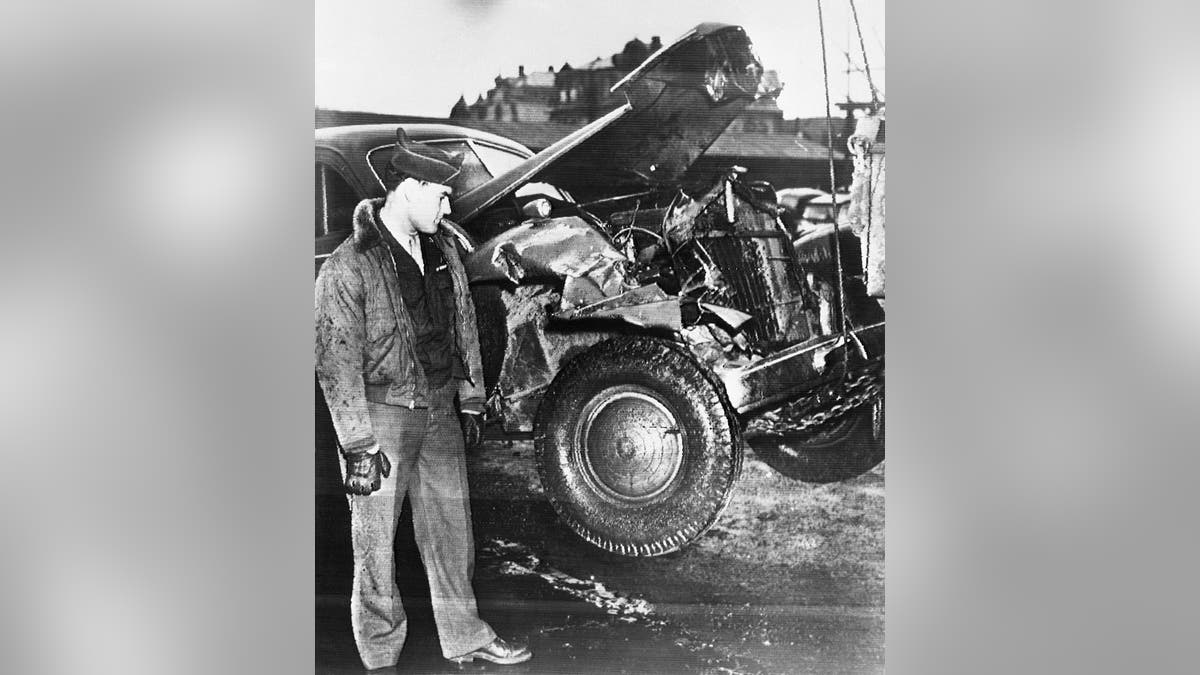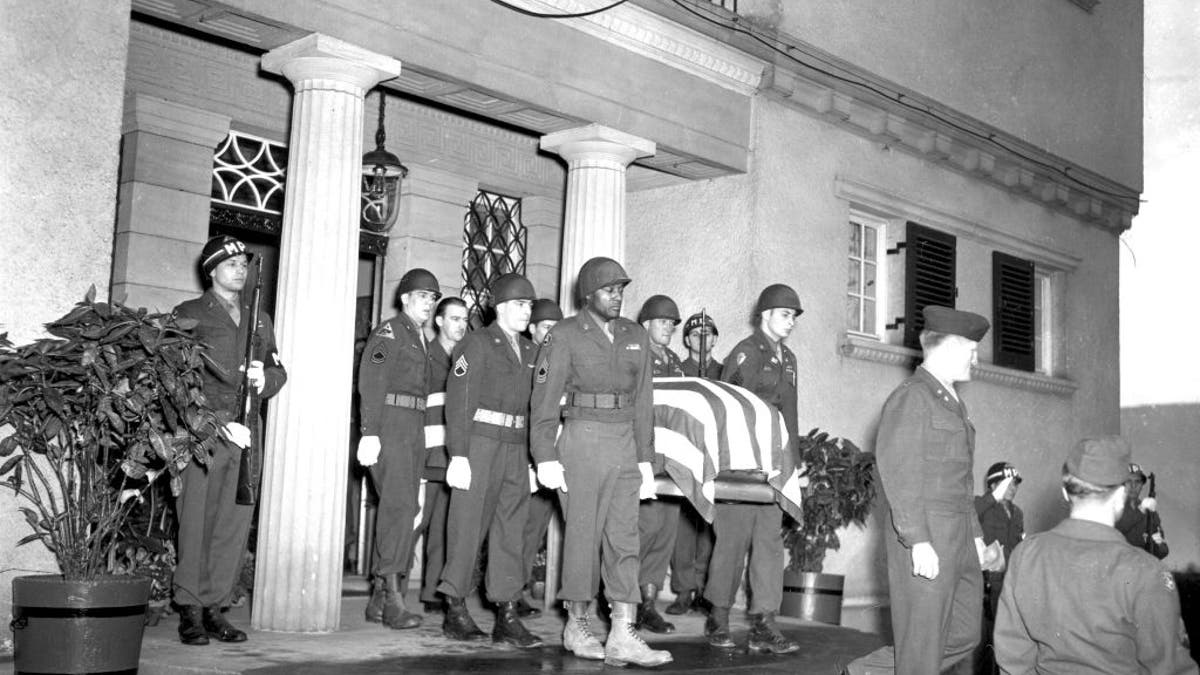General George S. Patton Jr., an American World War II hero famed for his battlefield brilliance, unvarnished view of combat and volatile personality, died in Heidelberg, Germany, on this day in history, Dec. 21, 1945.
He was 60 years old.
Patton was paralyzed in an auto accident on Dec. 9. "Old Blood and Guts" died in the hospital of a blood clot in his heart.
The general "led a life of adventure, fighting in almost every major American twentieth century conflict," the National World War II Museum notes.
"He often led from the front, and he almost always delivered victory," the same source also says. "His swift conquest of Sicily, his race across France, his relief of Bastogne during the Battle of the Bulge and his drive into Germany destroyed German armies, saved American lives and captured the collective imagination of the American public."

PFC. Horace L. Woodring, 19, Sturgis, Kentucky, General Patton's chauffeur, is shown looking at the smashed-in front of Gen. Patton's car. Woodring and the driver of the truck that crashed into the car were sent back to their outfits with no disciplinary action because previous records revealed that both were excellent drivers. (Getty Images)
Patton, an early champion of tank warfare, served under U.S. Army Gen. John Pershing in World War I.
He spent years after the war working on mechanized tactics and strategy — planning for another war overseas.
"We’re not just going to shoot the sons of b******, we’re going to rip out their living g******** guts and use them to grease the treads of our tanks," Patton barked at his troops before they entered battle, in one of his most memorable speeches.
ARMED SERVICES YMCA HELPS SERVICEMEN AND WOMEN COME FROM FROM THE HOLIDAYS
"We’re going to murder those lousy Hun b******* by the bushel f***ing basket."
Patton "produced more results, in less time, with fewer casualties than any other general, in any army, in World War II" — despite his boisterous rhetoric and reputation for recklessness — biographer Alan Axelrod said on the American Heroes Channel.
"Patton often led from the front, and he almost always delivered victory." — National WWII Museum
Patton was part of American occupation forces in Germany after the war when he headed out on a hunting trip with his friend, Major General Hobart R. Gay.

A painting for the U.S. Army "Stars and Stripes" newspaper shows U.S. Army General George S. Patton during the Battle of El Guettar in south-central Tunisia, March 1943. (Illustration by Ed Vebell/Getty Images)
Patton sat in the right rear seat of a 1938 Cadillac Model 75, driven by his chauffeur PFC Horace Lynn Woodring, 19, of Kentucky.
Gay sat next to Patton, behind the driver.
Patton "was commenting on the litter that war had left behind, piled up on both sides of the road near the quartermaster depot," according to a detailed chronicle of the accident by author Peter J. K. Hendrikx.
That's when a "2.5-ton 6x6 GMC truck, which was driving in the opposite direction, all of a sudden made a left turn toward the quartermaster depot."
AT CHRISTMAS, THE WISE MEN TAUGHT RAYMOND ARROYO: ‘KEEP YOUR GAZE ABOVE THE HORIZON’
Woodring had no way to avoid hitting the truck.
Added Hendrikx, "Patton was thrown forward and most likely hit his head on the railing above the rear of the driver’s seat. This took the skin ofo Patton’s forehead. General Gay and Woodring were only shaken up … [The general] fell on Gay’s lap, who asked Woodring to help him out from under Patton, since Patton couldn’t move."
Patton was rushed by ambulance to the hospital. A call went out when to the best doctors in Germany, England and the United States to treat the general.

Gen. George S. Patton is buried at the Luxembourg American Cemetery alongside over 5,000 other American soldiers killed in action in World War II. (Kerry J. Byrne/Fox News Digital)
There was nothing they could do.
Patton's accidental death after a life of combat, coupled with his outspoken views on World War II ally Soviet Union, has fueled conspiracy theories for more than 75 years.
"The man driving the truck and his two passengers quickly vanished after the incident. No criminal charges were ever filed. No accountability was ever recorded," Bill O'Reilly and Martin Dugard wrote in their 2014 book, "Killing Patton."
"It is foolish and wrong to mourn the men who died. Rather we should thank God that such men lived." — Patton
"Both the official accident report and several key witnesses soon went missing. And most ominous of all, a former American intelligence operative confessed in October 1979 that he had planned and participated in the assassination of Gen. George S. Patton Jr."
CLICK HERE TO GET THE FOX NEWS APP
Given Patton's outsized role in the Allied victory in Europe and his larger-than-life reputation in both sides of the Atlantic, the place of his burial became a topic of considerable international discussion.
The French government offered to have the American general buried in Napoleon's tomb in Paris, an honor that spoke to Patton's status in the eyes of newly liberated Europe.

Uniformed pallbearers carry the flag-covered casket containing the body of military commander George S. Patton (1885-1945) from the Villa Rainer, after which it was transported to Christ Church for the funeral, Heidelberg, Germany, Dec. 23, 1945. (Photo by PhotoQuest/Getty Images)
His wife, Beatrice, flew from Boston to be by his bedside after the accident and at first wished to have him interred near their Massachusetts home.
Mrs. Patton ultimately decided to have him buried in Europe.
Patton's accidental death after a life of combat … has fueled conspiracy theories for more than 75 years.
General Patton rests today at Luxembourg American Cemetery, alongside more than 5,000 other American soldiers, many killed in the Battle of the Bulge.
"His cross faces those of the men he led, as if he were leading them again for one last battle," writes the National World War II Museum.
CLICK HERE TO SIGN UP FOR OUR LIFESTYLE NEWSLETTER
"It is foolish and wrong to mourn the men who died," Patton once said, among his many famous quotes.
"Rather we should thank God that such men lived."
For more Lifestyle articles, visit www.foxnews.com/lifestyle.

